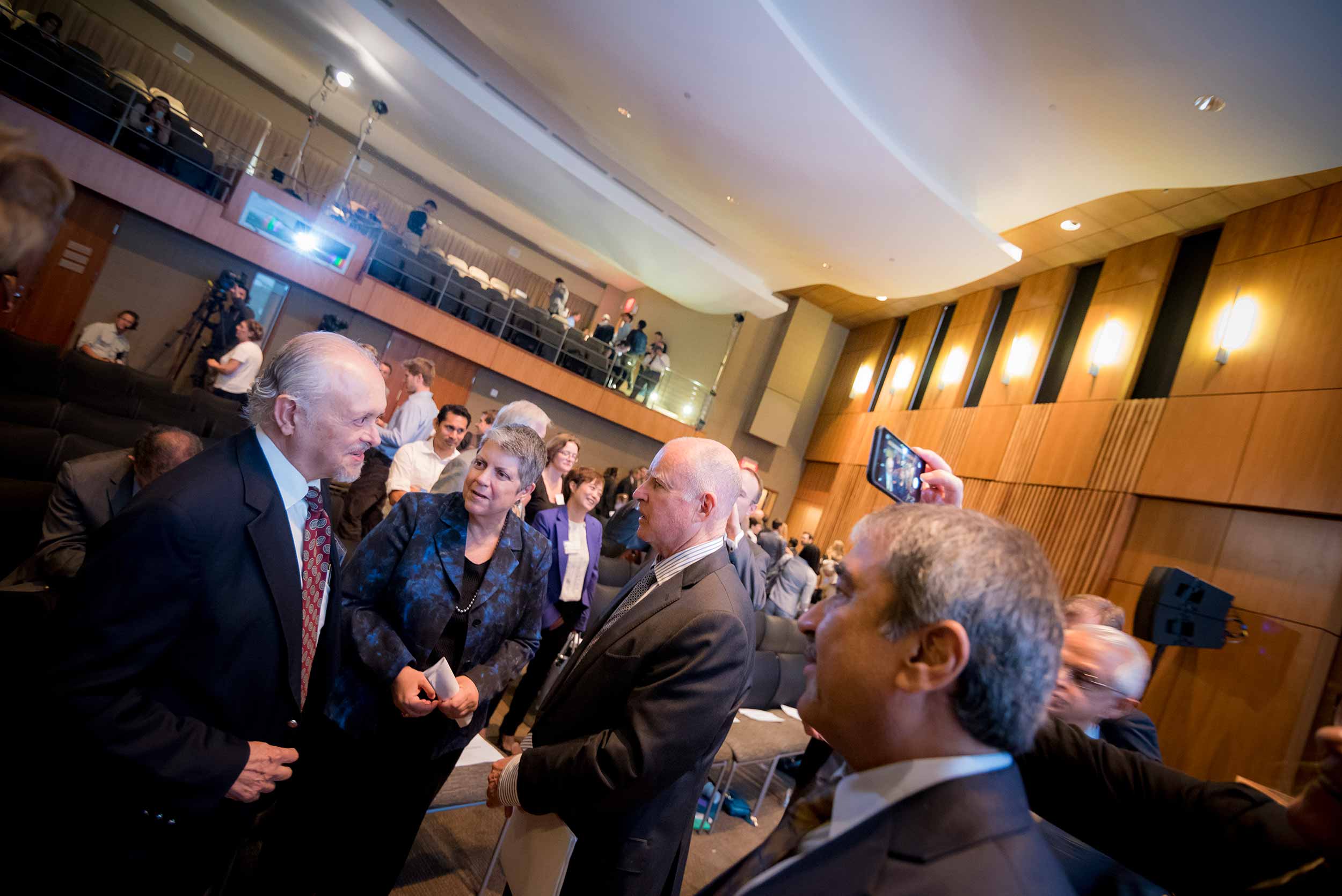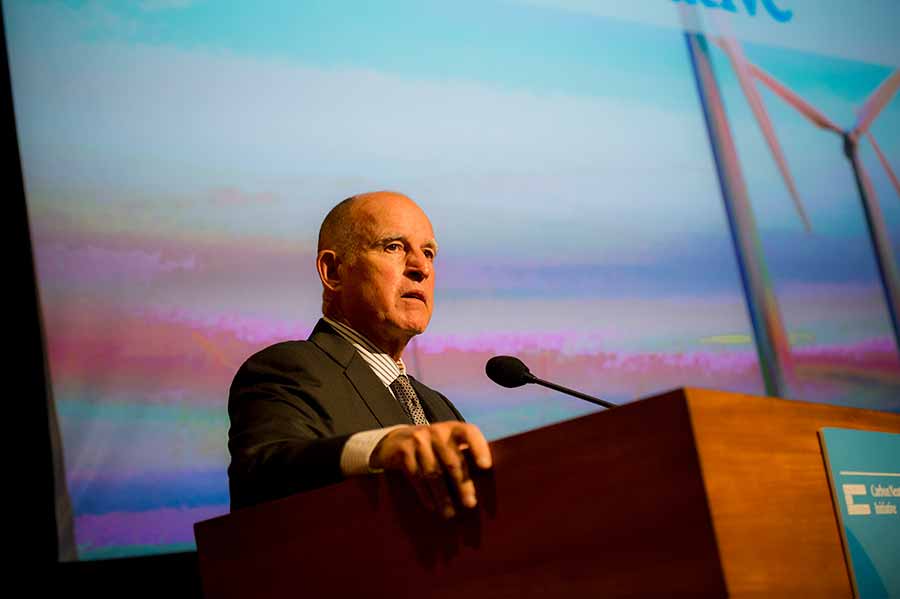By:
- Robert Monroe
Published Date
By:
- Robert Monroe
Share This:
Bending the Curve
In a two-day summit at UC San Diego, the University of California resolves to be a beacon for carbon neutrality

Photos by Erik Jepsen/UC San Diego Publications
University of California climate experts announced 10 scalable solutions for moving the world towards carbon neutrality at a summit held at UC San Diego that brought the state’s top climate researchers and policymakers into the same room.
The UC Carbon and Climate Neutrality Summit, held Oct. 26-27 at Scripps Institution of Oceanography, drew participants ranging from Gov. Jerry Brown, UC President Janet Napolitano, San Diego Mayor Kevin Faulconer and university chancellors to Nobel Prize winner Mario Molina and summit organizer and renowned Scripps climate and atmospheric scientist Veerabhadran Ramanathan.

Governor Brown addressed the summit.
Summit organizers released the scalable solutions as part of a report called “Bending the Curve,” the title a reference to the rise in global temperatures that has trended steadily upward for several decades as fossil fuel use and other practices contribute to a greenhouse effect in Earth’s atmosphere. The goal of the summit is to mitigate the worst consequences of climate change by disrupting this trend and abating the pace of warming.
The University of California is a natural place for innovations toward those ends, said UC San Diego Chancellor Pradeep K. Khosla.
“Sustainability is in our DNA at UC San Diego and in the entire University of California system,” Khosla said. “It is our responsibility and role to pioneer sustainable solutions through education, research and practice, so that we can ensure a better and healthier planet for future generations.”
Brown said the solutions from the UC Climate Solutions Group could help shape talks among global leaders at the United Nations Conference on Climate Change (COP21) in Paris this November. Napolitano expressed hope that the reach of the university’s efforts would extend well beyond Paris, however, in a vote of confidence in California’s ability to export innovations that eventually become commonplace worldwide.
“I anticipate that by 2025, when the University of California is carbon neutral, that the rest of the world in seeking climate solutions will say, ‘Well, let's go back to 2015 when they had that summit at UC San Diego, and let's see if we can do what the University of California did,’” Napolitano said.

Chancellor Pradeep K. Khosla hosted a panel of other UC Chancellors.
The UC Climate Solutions Group, composed of 50 top experts from all 10 UC campuses and the associated national laboratories, also stressed the moral implications of climate change in the executive summary of their report, highlighting that the people most at risk are the world’s 3 billion poorest people, while the majority of pollution is created by the wealthiest 1 billion.
“Fifteen percent of us contribute 60 percent of the pollution. We’re leaving behind a planet of uncertain future for our children, grandchildren and generations unborn,” said Ramanathan, chair of the UC Climate Solutions Group.
UC’s own quest to achieve carbon neutrality could play a noticeable role in reducing California’s carbon footprint even before the carbon neutrality initiative achieves its goal of being a “living laboratory” for the rest of the world.
Several speakers at the event noted that UC campuses – virtual “city-states” as Ramanathan termed them – are in most cases among the largest consumers of electricity in the cities in which they are located. With a collective population of 500,000 students, staff and faculty – the equivalent of what would be one of California’s largest cities – the 10 UC campuses will play a substantial role in helping the state meet its overall climate change-mitigation goals.

Janet Napolitano was a featured speaker at the summit.
The solutions presented reflect the major research themes of the summit’s main players. The first solution listed in “Bending the Curve,” for instance, is to immediately slow the pace of global warming by controlling emissions of short-lived climate pollutants such as methane, refrigerants, and the soot created by biomass burning.
Ramanathan has made such pollutants a major focus of his research in the past decade. He estimates that these pollutants have a collective atmospheric warming effect second only to that of carbon dioxide, the chief greenhouse gas created by human activities. The report authors pointed out that the technologies needed to drastically reduce these pollutants already exist and can be employed on a large scale immediately.
Indeed, an underlying message of the summit was that much of the technology needed to solve a giant problem already exists. Among the many statistics offered:
- The University of California’s recent purchase of 80 megawatts of solar power is the largest solar purchase by a university in the country.
- The microgrid of summit host UC San Diego meets 85 percent of the university’s electricity needs.
- The West Village residential area of UC Davis self-generates 82 percent of the electricity needs of the 2,000 people who live there.
- Despite being the most populous state in the U.S., California’s electricity use is 18 percent smaller than the national average.
- Even in California communities heavily dependent on fossil fuels, change is taking place. In oil-well-dotted Kern County, the second largest taxpayer is a wind energy project.
- San Diego has its own clean energy goal. By 2035, the city intends to obtain all its electricity from renewables.
- Twenty-seven percent of new homes built in Southern California have solar panels, what David Hochschild, a member of the California Energy Commission, termed “the gateway drug” to greater use of renewables.
- The price of solar power has plummeted, going from 50 cents per kilowatt hour in 2000 to just around four cents now.
- Besides cutting fossil fuel use, mitigation of pollutants such as black carbon and methane offer tremendous near-term benefits.
Brown was among several speakers to acknowledge the political resistance to addressing climate change prevalent among conservative lawmakers in the U.S. government. Nobel laureate and UC San Diego chemistry professor Mario Molina blamed that resistance for a “bottleneck in international climate negotiations.” Brown said that California, though, has continually proven climate doubters wrong by growing its economy while pursuing clean energy goals.

“What we do will be disseminated,” said Brown. “It will spread.”
Summit participants cast a hopeful tone, with some pointing to fossil fuel use as a 20th Century technology, supported in the United States by a subsidy created in 1926 with no expiration date. Fossil fuel now faces competition from superior energy resources that do not carry the same environmental and political baggage. Others noted that a change in public attitudes can happen fast, citing the example of the marriage equality movement, which went from nominally existent to securing Supreme Court support for gay marriage in the space of a decade.
California Energy Commission member Hochschild thought the carbon neutrality movement could take a lesson from how that movement changed minds. “As that issue became about sanctioning love between two people, the carbon neutrality movement boils down to concepts of justice and family. Whatever action is taken now, speakers said, ultimately equates to the quality of life this generation’s descendants will enjoy.”
Share This:
You May Also Like
Stay in the Know
Keep up with all the latest from UC San Diego. Subscribe to the newsletter today.



